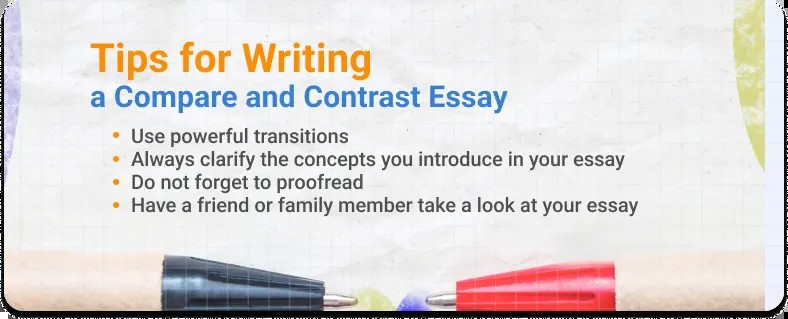Compare and contrast essays analyze the similarities and differences between two or more subjects. These subjects typically belong to the same category, allowing for meaningful comparison. This essay type is common in academic settings, requiring students to demonstrate analytical and comparative skills. A strong compare and contrast essay presents a clear central point, highlighting insightful conclusions drawn from the analysis. This guide provides a comprehensive breakdown of how to create an effective outline for a compare and contrast essay.
Brainstorming and Pre-Writing
Before outlining, brainstorm similarities and differences between your chosen subjects. List key characteristics, then delve deeper, considering less obvious aspects. Visual learners can use a Venn diagram, placing shared traits in the overlapping section and unique characteristics in the non-overlapping areas.
Alternatively, create a two-column list, comparing corresponding characteristics side-by-side. Avoid simply listing attributes without analysis. Focus on drawing meaningful conclusions and establishing connections between the subjects.
Choosing an Organizational Structure: Block or Point-by-Point
Two primary outlining methods exist: the block method and the point-by-point method.
Block Method: Discuss all aspects of the first subject in one block, followed by a separate block discussing all aspects of the second subject. This approach simplifies writing but may require more effort from the reader to draw comparisons.
Point-by-Point Method: Analyze each similarity or difference point by point, alternating between subjects. This method highlights comparisons directly but can feel repetitive if not carefully crafted.
Detailed Outline Structures
Point-by-Point Outline Example: Comparing Cars and Motorcycles
I. Introduction
- Hook: Engaging statement about transportation choices.
- Thesis Statement: Cars and motorcycles offer distinct advantages and disadvantages depending on individual needs and circumstances, such as lifestyle, financial considerations, and urban environment.
II. Body Paragraph 1: Lifestyle
- Topic Sentence: Motorcycles offer a more adaptable lifestyle compared to cars.
- Motorcycles: Easier storage, quicker learning curve.
- Cars: Larger footprint, require more significant lifestyle adjustments, demand more comprehensive driver training.
III. Body Paragraph 2: Finances
- Topic Sentence: Motorcycles generally present a more economical transportation option than cars.
- Motorcycles: Lower purchase price, simpler maintenance.
- Cars: Higher initial cost, more expensive repairs and fuel consumption.
IV. Body Paragraph 3: Urban Environment
- Topic Sentence: Cars provide advantages in navigating larger urban areas, while motorcycles excel in dense, narrow cityscapes.
- Motorcycles: Maneuverability in congested areas, higher risk in heavy traffic.
- Cars: Safer in high-speed environments, less practical in tight spaces.
V. Conclusion
- Restate Thesis: Summarize the key differences and reiterate the dependence on individual needs.
- Concluding Thought: Offer a final observation about the evolving landscape of transportation choices.
Block Method Outline Example: Comparing Cars and Motorcycles
I. Introduction
- Hook: Engaging statement about transportation choices.
- Thesis Statement: Cars and motorcycles offer distinct advantages and disadvantages depending on individual needs and circumstances, such as lifestyle, financial considerations, and urban environment.
II. Body Paragraph 1: Motorcycles
- Topic Sentence: Motorcycles offer advantages in terms of lifestyle, cost, and maneuverability in specific urban settings.
- Lifestyle: Easier storage, quicker learning curve.
- Finances: Lower purchase price, simpler maintenance.
- Urban Environment: Maneuverability in congested areas, higher risk in heavy traffic.
III. Body Paragraph 2: Cars
- Topic Sentence: Cars provide benefits related to safety, comfort, and adaptability to diverse environments.
- Lifestyle: More spacious, require more significant lifestyle adjustments.
- Finances: Higher initial cost, more expensive repairs and fuel consumption.
- Urban Environment: Safer in high-speed environments, less practical in tight spaces.
IV. Conclusion
- Restate Thesis: Summarize the key differences and reiterate the dependence on individual needs.
- Concluding Thought: Offer a final observation about the evolving landscape of transportation choices.
Essential Elements for a Strong Essay
Evidence: Support claims with credible evidence: personal experiences, research data, expert opinions.
Transitions: Use transition words (similarly, likewise, in contrast, however) to connect ideas and guide the reader.
Clarity and Conciseness: Define terms, explain unfamiliar concepts, and maintain a focused argument.
Proofreading: Thoroughly review for grammar, spelling, and punctuation errors.
By following these guidelines, you can construct a well-organized compare and contrast essay that effectively analyzes your chosen subjects and delivers a clear, insightful message. Remember to tailor your outline and essay to the specific requirements of your assignment.
